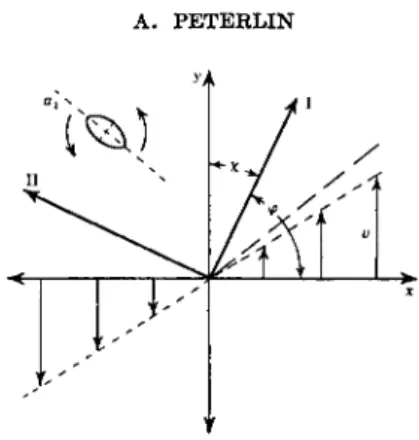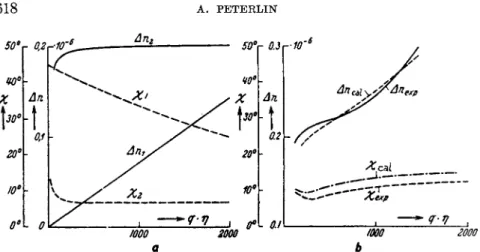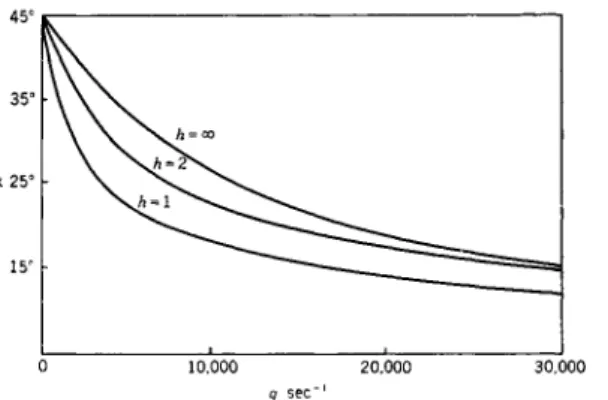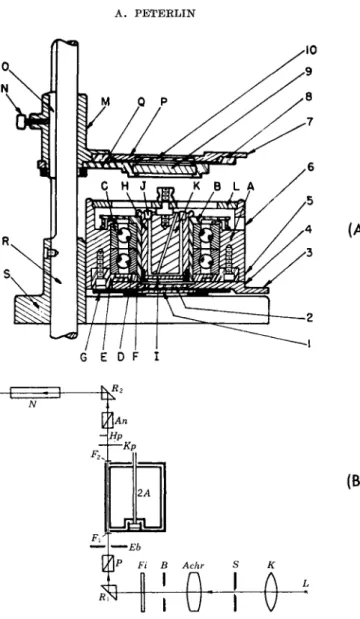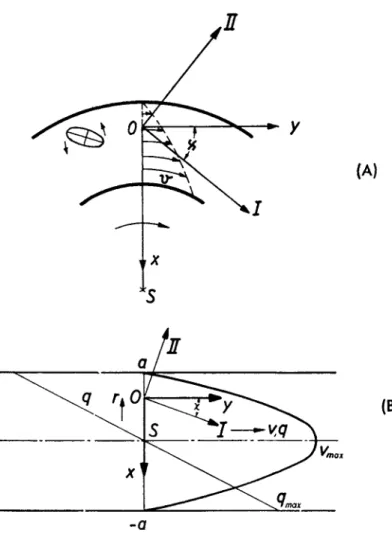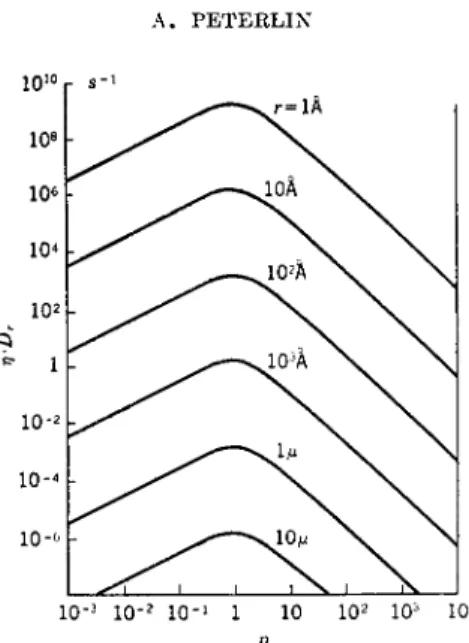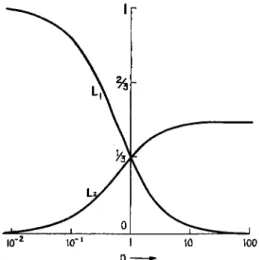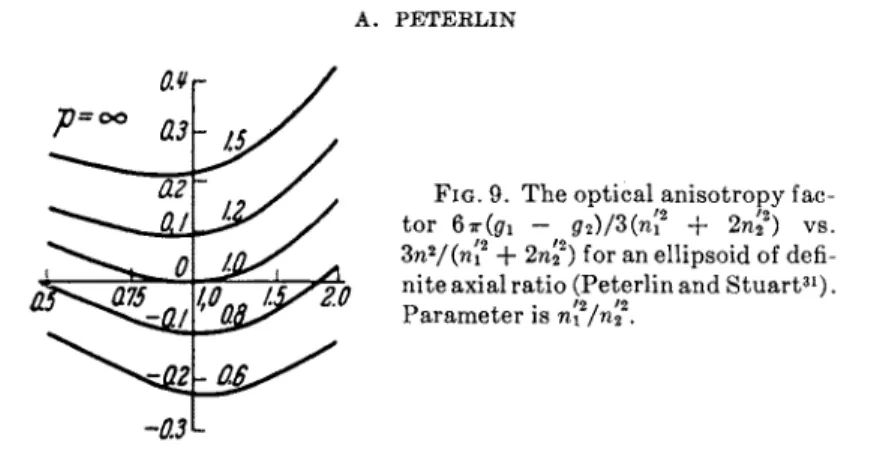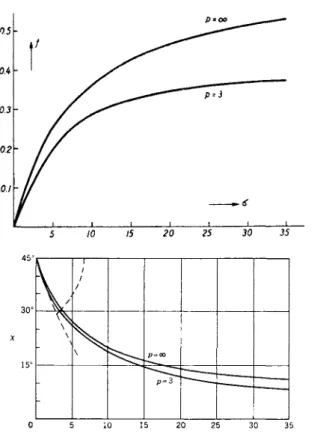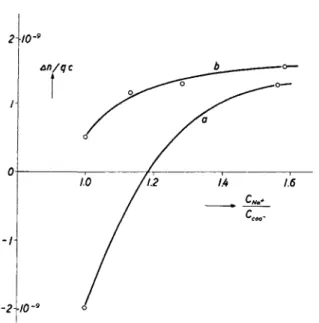CHAPTER 15
STREAMING AND STRESS BIREFRINGENCE A. Peterlin
I. Streaming Birefringence 615
1. Introduction 615 a. The Effect 615 b. Polydispersity 617 2. Apparatus 619 3. Low-Molecular-Weight Liquids 622
a. Experimental Results 622
b. Theory 623 4. Suspensions of Rigid Particles 624
a. Experimental Data 624 b. Orientation Theory 625 5. Solutions of Linear Macromolecules 629
a. Experimental Results 629 b. The Theoretical Treatment 631
(1) The Necklace Model 631 (2) Elastic Sphere Model 634 c. Molecular-Weight Dependence 636 d. Influence of the Solvent 637 e. Concentrated Solutions 638 II. Stress Birefringence . 643
1. Introduction 643 2. The Orientation Birefringence 645
a. Birefringence of the Amorphous Network 645 b. Birefringence of the Polycrystalline Solid 648
c. Birefringence of gels 650
Nomenclature 652
I. Streaming Birefringence1 1. INTRODUCTION
a. The Effect
Most liquids in laminar flow characterized by
vy = qx, (1)
1 There are many very good reviews of this subject: R. Cerf and H. A. Scheraga, Chem Revs. 51, 185 (1952); J. T. Edsall, Advances in colloid Sei. 1, 269 (1942); W.
Kuhn, H. Kuhn, and P. Buchner, Ergeb. exakt. Naturw. 25, 1 (1951); A. Peterlin 615
II
J
i y
1
A I
Mi"
'
.
X
FIG. 1. Principal axes n\ (I) and ni (II) in the flow plane.
exhibit a birefringence increasing steadily with the velocity gradient q. The volume element behaves like a biaxial crystal with the optical axes in the flow plane XY2. Since in most cases the effect is observed in a cylindrical apparatus, the light beam being parallel to the Z-axis, only the optical be- havior in that plane is of interest. The preferential directions of the largest and the smallest refractive index do not coincide with the X- and F-axis, the extinction angle χ lying between the limits 45 and 0 deg. (Fig. 1). The birefringence is positive when n\ > n2 and negative when n\ < n2.
The measured phase difference Δ in radians is defined by
Δ = 2TT (ni — n2)l (2)
with I the length of the path of light through the streaming fluid, the bire fringence
Δη = m - n2 = ^- = fi(q) λΔ (3) being a function of the velocity gradient. The same applies to the extinc- tion angle
X = Mq) (4) At small gradients and particles, An is proportional to q, and χ = 45 deg.
At higher values of q deviations of the proportionality of An to q set in and x falls off, essentially approaching 0 deg. (Fig. 2).
Streaming birefringence has been observed in simple low-molecular liquids and in solutions and suspensions of geometrically and optically
and H. A. Stuart, Hand-u. Jahrb. ehem. Phys. 8/IB, 1 (1943); ''Physik der Hochpoly- meren," (H. A. Stuart, ed.), Vol. 2, 569, 1953; R. Cerf, J. Polymer Set. 12, 15 (1954).
2 A. Peterlin and H. A. Stuart, Z. Physik 112, 1 (1939). Earlier observations of H.
Diesselhorst and H. Freundlich, Physik. Z. 16, 419 (1915), of V205 soles in capillary tubes gave uniaxial symmetry for the flow birefringence. That only applies for the capillary on the whole or for the volume element with χ = 0, respectively.
STREAMING AND STRESS BIREFRINGENCE 617
0 2 4 6 8 10 12 F I G . 2. Relative birefringence and extinction angle of cotton yellow (Baumwoll- gelb) after Boeder3; Dr = 0.1 s~l (samples 1, 2, and 3) and 0.2 s"1 (sample 4).
anisotropic molecules or particles. Rigid spherical particles (e.g., solutions of globular proteins) show no effect.
In laminar flow the anisotropic particles are compelled to rotate with a nonuniform angular velocity ω(φ). They stay longer in a given direction φ, the lower the corresponding ω. The Brownian motion, however, tends to counteract the hydrodynamic orientation. The competition of both influ- ences establishes the actual angular distribution of the particles and yields the extinction angle as the direction of minimum or maximum angular density, the birefringence follows as the difference of the corresponding densities multiplied by the optical anisotropy of the single particle. It will be seen that the orientation is not static as, for instance, in electric or mag- netic birefringence, but the particles rotate in the fluid and do not rest in their position.
The orientation of the particles during the flow may also cause viscosity changes. In concentrated solutions such a gradient dependence of the vis- cosity actually exists, the fluidity increasing the greater the gradient. In very dilute solutions, however, this influence is not so obvious and usually a nearly complete orientation of linear macromolecules, χ —> 0, occurs without any measurable change of the viscosity.
b. Polydispersity
All colloidal suspensions and macromolecular solutions are polydisperse both in shape and size of the solute particles. In very dilute solution every
3 P. Boeder, Z. Physik 75, 258 (1932).
50*r 0,2r-f0~*
X
20' 10°
0 L 0
r 0.3
Δη
rt
0.2
V L nt
rfO-6 .
/ ' änCi\y^onexp
, —**<τν ,
WOO 2000 2000
FIG. 3. Birefringence and extinction angle in a mixture of molecular and micellar cellulose acetate in cyclohexanone after Sadron and Mosiman:5 (a) the pure compo- nents, (6) the mixture.
type, i, of particle gives its own contribution to the optical polarization tensor P independently of the other particles present
(5)
Pjk — Z^ Pjk,i
Hence Sadron4 deduces
(An)' =
(?
Am sin 2χ{y + (?
Am cos 2χ; i andΣ Ani s m 2Χί
tan 2X = ^ - —
2^ Am cos 2xt·
(6)
(7) The summations are to be carried out over all species of particles which, if present alone in the flowing solution, would give the observed values Arii and xi of the birefringence and extinction angle at a given velocity gradient.
Figure 3 shows the calculated and observed values for a mixture of molecu- lar and micellar cellulose acetate in cyclohexanone after Sadron and Mosi- mann.5 The polydispersity, in this special case the simultaneous presence of very large, easily orientable, and very small particles gives rise to such strik- ing effects as a nonvanishing extinction angle at high gradients and a quite irregular variation of the birefringence6 with q.
4 C. Sadron, J. phys. radium [7] 9, 381 (1938).
6 C. Sadron and H. Mosimann, / . phys. radium [7] 9, 384 (1938).
60 . Snellman and S. Säverborn, Kolloid-Beihefte 52, 467 (1941); V. N. Tsvetkov and A. Petrova, J. Tech. Phys. (U.S.S.R.) 14, 289 (1944); Rubber Chem. and Tech- nol. 19, 350 (1946); R. Signer and H. W. Liechti, J. makromol. Chem. 2, 267 (1948);
STREAMING AND STRESS BIREFRINGENCE 619
FIG. 4. The extinction angle for monodisperse sys- tem (h — oo) of rigid ellips- oids and for polydisperse systems having a Gaussian distribution of particle lengths (h = 1 and 2) after Scheraga.7
0 10,000 20,000 30,000 q sec"1
For some special distribution functions of rodlike particles Scheraga7 and Goldstein8 have calculated birefringence and extinction angle (Fig. 4). No such attempt has yet been made for solutions of coiled linear macromole- cules.
2. APPARATUS
For the study of streaming birefringence a concentric cylinder apparatus (Couette) is mostly used. A standard design9 (with rotating outer cylinder) and the optical arrangements are shown in Fig. 5. The smaller the ratio of the gap width r2 — n to the mean radius r = (n + r2)/2, the more the velocity field approaches plane, linear, flow (Fig. 6a). The mean gradient is given by
A wide range of gradient, very desirable in most investigations, can only be achieved by changing ω and the gap width r2 — n. For pure liquids and dilute solutions of linear high polymers very high gradients are needed (several thousand per second), whereas suspensions of larger particles, like those of tobacco mosaic virus or thymonucleic acid, may require low gradi- ents of the order of 100 sec."1. The larger the variation of the extinction angle χ which can be observed, the more information may be deduced from the experiments.
Whenever small gradients suffice a relatively large intercylinder gap (a few milimeters) and slow speeds of rotation are permissible. It is more con- venient to rotate the inner cylinder. In this case there are also no special difficulties with the optical arrangement. Large gradients, however, require / . chim. phys. 44, 58 (1947); V. R. Gray and A. E. Alexander, / . Phys. & Colloid Chem. 52, 9 (1949).
7 H. A. Scheraga, J. Chem. Phys. 19, 983 (1951).
8M. Goldstein, / . Chem. Phys. 20, 677 (1952).
9 J. T. Edsall, A. Rich and M. Goldstein, Rev. Sei. Instr. 23, 846 (1952).
(A)
G E D F I
b?
2F2,
F /
ί
-Kp
US
2A (B)
Eb P Fi B
I
Achr
I I
FIG. 5. Cylinder apparatus, (a) Apparatus of Edsall, Rich, and Goldstein.9 K is the stationary inner cylinder; the rotating outer cylinder B holds a removable cup H in which the liquid is placed. (6) The optical arrangement of Buchheim, Stuart, and Menz.16 L is the light source; K, Achr lenses; S, B, and Eb diaphragms; Fi, filter; P, An polarizers; Kp, compensator; Hp, half shadow plate; N, telescope.
a narrow gap, introducing more stringent requirements as to the accuracy of the alignment of the optical system in order to avoid reflections from the cylinder walls.10 In low-viscosity liquids the upper limit for the gradient is given by the turbulence which appears appreciably earlier when the inner
« Y. Björnstahl, J. Opt. Soc. Amer. 29, 201 (1939).
STREAMING AND STRESS BIREFRINGENCE 621
(A)
^ \ < 7
Λ Οχΐ
' ^^"^^
(B)
FIG. 6. Velocity and gradient distribution in the cylinder apparatus (a) and in -σ the capillary (b) with the corresponding principal axes ri\ and ni .
cylinder rotates. Therefore apparatus with outer-cylinder rotation are pre- ferred in spite of the many ensuing troubles. Liquids of high viscosity, however, very soon produce a very high temperature gradient throughout the gap. Apart from irregular orientation, this causes the light beam to spread and to strike the walls; as its intensity drops rapidly to zero the measurements are progressively prevented.11 The details of the mechanical and optical parts of the apparatus can be found in numerous papers and monographs on the subject.12
11 Y. Björnstahl. Z. Physik. 119, 245 (1942).
12 See the review articles,1 and footnotes 7, 16, 17, and 18; C. Sadron, Schweiz.
Arch, angew. Wiss. u. Tech.Z, 8 (1937); G. Boehm, Handbuch biol. Arbeitsmeth., 24,
If the effect is very large, streaming birefringence may be also observed in capillaries.13 This applies to solutions of very large molecules and to suspensions of large anisometric particles, e.g., tobacco mosaic virus prep- arations, V2OB sols, etc. The velocity gradient has its maximum at the walls and vanishes in the axis of the capillary (Fig. 66). Hence only the average of the birefringence over the capillary cross section is observed when looking perpendicularly through the capillary. Better suited are rectangular capil- laries in which observation from the narrow side permits observation of the gradient dependence of the birefringence from q = 0 in the center to
<7max. on the walls.14
3. LOW-MOLECULAR-WEIGHT LIQUIDS
a. Experimental results
Liquids with anisometric molecules, such as benzene and alcohols, show a precise proportionality of the birefringence to the gradient, the extinction angle remaining at 45 deg. Such temperature dependence as exists is due to the corresponding change of the refractive index and the viscosity η.
Hence, by writing
An = M'vq (9) the characteristic Maxwell constant M1 of the liquid
m\q
does not depend on temperature. This was shown for benzene by Winkler and Kast15 in the temperature range from 10 to 60° C. In the close neigh-
3939 (1939); J. W. Mehl, Biol. Bull. 79, 488 (1940); H. Nitschmann and H. Guggis"
berg, Helv. Chim. Ada 24, 434, 574 (1941); A. J. de Rosset, / . Chem. Phys. 9, 766 (1941) ; M . Gerendas, Enzymologia 9, 123 (1941); J. T. Edsall, C. G. Gordon, J.
W. Mehl, H. Scheinberg, and D. W. Mann, Rev. Set. Instr. 15, 243 (1944); N. V.
Tsvetkov and A. Petrova, / . Tech. Phys. (U.S.S.R.) 12, 423 (1942); A. S. C. Lawrence, J. Needham, and S. C. Shen, / . Gen. Physiol. 27, 201 (1944); E. Fredericq and V.
Desreux, Bull. soc. chim Beiges 56, 223 (1947); J. T. Edsall, Fortschr. ehem. Forsch.
1, 119 (1949); V. R. Gray and A. E. Alexander, J. Phys. & Colloid Chem. 53, 9 (1949);
A. G. Ogston and I. E. Stanier, Biochem. J. 53, 4 (1953).
13 H. Zocher, Z. physik. Chem. 98, 296 (1921); M. Aschenbrenner, Z. physik. Chem.
127, 415 (1927); W. Philippoff, Kolloid-Z. 83, 163 (1938); K. Hess, H. Kiessig, and W.
Philippoff, Naturwiss. 26, 184 (1938).
14 H. Freundlich, H. Diesselhorst, H. Zocher, C. Schuster, and F. Stappelfeldt, see "Kapillarchemie, 4th ed., Vol. 2. Akad. Verlagsges., Leipzig, 1932; Y. B j ö r n s t a h l , Thesis, Uppsala, 1924; W. Ostwald and H . E r b r i n g , Kolloid-Z. 64, 231 (1933); A.
Peterlin and M . Samec, Kolloid-Z. 109, 96 (1944).
15 E . Winkler and W. K a s t . Naturwiss. 29, 288 (1941); E . Winkler, Z. Physik. 118, 232 (1941).
STREAMING AND STRESS BIREFRINGENCE 623
TABLE I
Temperature, °C. M' X 1010 Benzene16
Nitrobenzene17 Toluene16 Heptylalcohol18 Undecylalcohol18
15 20 15
0.93 2.75 1.04 0.45 0.94
0.00694 0.020 0.00621 0.070 0.152
borhood of the melting point, however, a sharp increase of nearly 50 % was found. Surprisingly, the corresponding viscosity behavior is quite normal.
Some values of the Maxwell constant are given in Table I. Some meas- urements were also made with liquid crystals, showing a very strong flow orientation.19
b. Theory
The theoretical treatment starts from the same assumptions as in the case of suspensions of rigid particles. Every molecule is represented by a rigid ellipsoid moving with laminar Αολν as required by the laws of hydro- dynamics. As a consequence of the smallness of the molecules, the Brownian motion is so strongly predominant that merely the initial linear part of the birefringence function [equation (20)], with constant extinction angle χ = 45 deg., is observed, and the parameter σ stays below 10~4 even for the largest molecules. The Maxwell constant is given by
M> = £ ( ^ ± -
2Y N ^ ^ (11)
15 \ 3n / Ότη
In spite of the obvious objections to the use of the hydrodynamical treat- ment of molecular motion in flow and to the use of the Lorentz-Lorenz inner field, the results are not in contradiction with other experimental methods, e.g., with electrical birefringence yielding the optical anisotropy, and the relaxation time r = }/^Ώτ, where Dr is the rotatory diffusion con- stant. As a matter of fact, the geometrical dimensions of single molecules deduced from Dr, are only a little smaller than those from X-ray measure- ments. This difference is usually explained by the assumption that the
16 W. Buchheim, H. A. Stuart, and H. Menz, Z. Physik. 112, 407 (1939).
17 C. Sadron, J. phys. radium [7] 7, 263 (1936).
18 O. Snellman and Y. Björnstahl, Kolloid-Beihefte 52, 403 (1941).
19 W. Tsvetkov and W. Marinin, Ada Physicochim. U.R.S.S. 13, 219 (1940); V. N.
Tsvetkov, Acta Physicochim. U.R.S.S. 19, 86 (1944).
20 For the symbols see equations (15), (16) ,and (17).
actual viscosity during the rotation of the molecule is smaller by a small fraction than the macroscopic viscosity of the liquid.
Raman and Krishnan21 have proposed a static orientation theory considering only the dilatation part of the flow and obtained
/n2 + 2 \2 4x V 3n / 5
1 ° ' " kT 2oi + a2
with χ = 45 deg. for all gradients. Narasimhamurty,2 2 Paldhikar,2 3 and Rao24 have applied this theory to some liquids and found the calculated values of M' nearly a third smaller than the experimental data. In spite of this partial agreement, the Raman-Krishnan theory cannot be correct because it does not allow an extension to larger particles which exhibit χ <45 deg.
4. SUSPENSIONS OF RIGID PARTICLES
a. Experimental data
Colloidal systems with nearly rigid nonspheric particles, as for instance tobacco mosaic virus suspensions,25 V205 sols,26 and asymmetrical proteins from plasma27 show a large birefringence with pronounced saturation effects and a net dependence of the extinction angle on the velocity gradient, as may be seen from Fig. 2 (cotton yellow). In many cases the effect is very easy to observe and so the wide use of streaming birefringence measure- ments in biological research for determination of the particle shape and size can be understood. Even if the precise dimensions cannot be deduced, the existence of an observable effect demonstrates a deviation from spherical shape which sometimes may be sufficient for practical purposes. Also changes in particle size, for instance during coagulation or pH change, may be easily detected since they very strongly influence the amount and the gradient dependence of the flow birefringence and of the extinction angle.
21 C. V. Raman and K. S. Krishnan, Phil. Mag. [7] 5, 769 (1928).
22 T. S. Narasimhamurti, Proc. Indian Acad. Sei. 35A, 126 (1952).
23 R. Paldhikar, Phil. Mag. [F] 21, 1125 (1936).
24 A. B. Rao, Proc. Indian Acad. Sei. 5A, 124 (1937).
25 W. N. Takahashi and T. E. Rawlins, Proc. Soc. Exptl. Biol. Med. 30, 155 (1932);
M. A. Lauffer and W. M. Stanley, J. Biol. Chem. 123, 507 (1938); M. A. Lauffer, J.
Phys. Chem. 42, 935 (1938); G. A. Kausche, H. Guggisberg, and A. Wissler, Naturwiss.
27, 303 (1939); R. Robinson, Proc. Roy. Soc. (London) A170, 519 (1939); A. Wissler, Thesis, Bern, 1940; M. Joly, Bull. soc. chim. biol. 30, 404 (1948); 31, 108 (1949); J. B.
Donnet, Compt. rend. 229, 189 (1949); Thesis, Strasbourg, 1952.
26 K. Saito, / . Chem. Soc. Japan 64, 197 (1943); P. Ullyott, Trans. Am. Soc. Mech Engrs. 69, 245 (1947); J. B. Donnet, H. Zbinden, H. Benoit, M. Daune, N. Dubois, J. Pouyet, G. Scheibling, and G. Vallet, / . phys. radium [8] 10, 25 (1949); J. B. Don- net, / . chim. phys. 47, 698 (1950); Thesis, Strasbourg, 1952.
27 There are a great many investigations on proteins (e.g., by Edsall and co-work- ers). For references see the excellent compilation of Cerf and Scheraga,1 where prac- tically all work on colloid systems till December, 1951, is reported.
STREAMING AND STRESS BIREFRINGENCE 625 Many measurements, especially of biological objects and for biological purposes, have also been made at higher concentrations when the interac- tion effects are predominant, yielding valuable information on the investi- gated system. In such solutions the birefringence increases more than pro- portionally to the concentration and the extinction angle becomes concen- tration-dependent. Joly28 has tried to deduce an interaction function be- tween the particles from his measurements of concentrated solutions.
Since it is not easy to change the solvent in a colloid solution without altering the particles, only few streaming birefringence experiments29 of this kind exist from which the influence of the solvent-refractive index on the optical anisotropy gi — g2 [equation (19)] could be deduced.
In bentonite suspensions the effect is so large that it can be used for in- vestigations of the streaming in pipes. Häuser and Dewey30 use a 1 % sus- pension for observations of the turbulent flow. The particle dimensions are less than 50 ηΐμ.; the viscosity of the suspension equals that of water.
b. Orientation Theory
The theory of the effect in dilute suspension without hydrodynamic and optical interaction between the particles was given by Peterlin and Stuart.31 For simplicity's sake the model particle is assumed to be a rigid rotational ellipsoid with the symmetry axis 2αι and the perpendicular axis 2α2, the axial ratio
p = — > 1 for elongated, rodlike particles
Ü2
< 1 for flattened, disklike particles
and the volume v = 4παια22/3 = 47τρα23/3 = 47rr3/3 being the characteristic geometric parameters of the particle. The ellipsoid symmetry axis rotates in laminar flow with a nonuniform angular velocity
0 = (gb/4) sin 20 sin 2φ \ ( . Φ = q{\ + b cos 2<p)/2 J U ; with
b = (p2 - l)/(p2 + 1) (15)
28 M. Joly, Trans. Faraday Soc. 48, 279 (1952); Kolloid-Z. 126, 77 (1952).
29 M. A. Lauffer26 examined TMV in glycerol-aniline-water mixtures and found n\ = n2' = n' — 1.57. Similar studies were performed by R. Cerf, Compt. rend. 226, 405 (1948) on silk fibroin, by J. K. Backus and H. A. Scheraga [/. Colloid Sei. 6, 508
(1951)] on detergent micelles and by C. Hocking, M. Leskovsky, Jr., and H. A.
Scheraga [J. Am. Chem. Soc. 74, 775 (1952)1 on bovine fibrinogen.
30 E. A. Hauser and D. R. Dewey, Ind. Eng. Chem., Ind. Ed. 31, 786 (1939); J.
Phys. Chem. 46, 212 (1942).
31 A. Peterlin and H. A. Stuart, Z. Physik. 112, 1 (1939).
32 G. B. Jeffery, Proc. Roy. Soc. (London) A102, 161 (1922).
(13)
FIG. 7. The rotational diffusion constant Dr = kT/Wr at 20° C. as function of the axial ratio p for different particle volumes ^ = 4? ?,3/3 (Peterlin and Stuart1).
where b = 1 for a very extended rod with p = GO } 0 for a sphere, and — 1 for a very flat disk (p = 0). The distribution function F of the symmetry axes in the flow is determined by the competition of the hydrodynamic rotation [equation (14)] and the Brownian motion characterized by the rotational diffusion constant (Fig. 7).
Dr = kT/Wr (16)
where k = Boltzmann constant, Wr = momentum of resistance against the rotation of the symmetry axis with constant angular velocity 1 in a suspen- sion with η = 1. F was obtained as a very slowly converging series of spherical harmonics. For small gradients it may be transformed to
' - £ 0 +
4Dqb r sin 2φ sin Θ + (17) where N = number of particles in the unit volume (cubic centimeter). The function F has its maximum (minimum) at φ = 45 deg. (135 deg.) for elongated ellipsoids (6 > 0) and at 135 deg. (45 deg.) for disklike particles (b < 0). If q is increased more terms in the series expansion equation (17) must be taken into account, the maximum (minimum for b < 0) shifting to larger φ = 90 deg. — χ with the limit 90 deg. for σ = q/Dr = oo.The particle distribution F yields ä birefringence of the suspension An = 2ΚΝΌ £ ^ fPM = 2TC ^-Z_£? /ρ(σ)
n n
x = XpM
(18)
STREAMING A N D STRESS BIREFRINGENCE 627
I0"2 10"' 1 10 100 p — -
FIG. 8. The depolarization factors L\ and L% for rotational ellipsoids (Peterlin and Stuart2).
with the optical anisotropy of the particle33
. (rii — n2) — 2 {L\ — L2)
gi — 92 = T 7 7T 5 W 7^ 5 \ (19)
the depolarization factors Li and L2 only depending on the axial ratio p (Fig. 8).
The optical anisotropy of rigid ellipsoids34 may have two sources. The material can be anisotropic, having different refractivity n/ in different directions (intrinsic anisotropy). Further the shape of the ellipsoid, by the depolarization effect of the induced surface charges, reduces the polarization the more the smaller the dimensions of the ellipsoid in that direction (shape anisotropy—Formanisotropie). Spherical particles have L\ = L2 = Vz\ their optical anisotropy is entirely due to the intrinsic anisotropy of the particle material (e.g., quartz spheres). Elongated (flattened) ellipsoids, however, of isotropic material (for instance, NaCl) have a pure shape anisotropy proportional to (n'2 — n2)2(L2 — Li), vanish- ing at n — n'.ln anisotropic material the shape anisotropy disappears with a consecutive sign change of the birefringence when the solvent refraction index n equals the particle principal value n / or n2' (Fig. 9).
33 Equation (19) is deduced by the quasistatic treatment of the optical field which is only applicable when all dimensions of the particle are much smaller than λ/2πη ~ 1000 A..
34 In deformable material also the stress birefringence may contribute to the op- tical anisotropy of the particle. See equation (34).
FIG. 9. The optical anisotropy fac tor 6 7r(gri <72)/3(ηί2 + 2n22) vs.
Zn2/(n[2 + 2n£) for an ellipsoid of defi- nite axial ratio (Peterlin and Stuart31).
Parameter is n'x/n2.
-0.3 L
The functions fp and χρ have been given by Peterlin and Stuart31 as very slowly converging series in powers of the parameter b. Scheraga, Edsall, and Gadd, Jr.,35 have performed the numerical summation for various values of p. In Fig. 10 the birefringence function / and the extinction angle are shown for p = 3 and p = oo as functions of the parameter σ.
For small values of σ the functions / and χ can be expanded in series
An = 27TC, 0i — 92 ba
K4(-I) + -]
(20)showing the initial linear dependence of An and χ on the velocity gradient.
The limiting slopes at the origin give the characteristic constants of the suspended particle, the specific Maxwell constant
M' = An = 2TT gi_
ncvr\q 15
and the intrinsic orientation constant JL2 J L
DrV
2w gj_
15 JfrbWr kT
[ω] = lim π/4 - χ
αη \2Ότη
In most cases the quotient
M'sp = 8π gi — g2,
[ω] 5 n2
12/cT
(21)
(22)
(23) gives directly the optical anisotropy of the particles, since b, with a suffi- cient accuracy, may be put equal to ± 1 . A very unpleasant complication however arises from the volume concentration cv = cg/p with p = density
35 H. A. Scheraga, J. T. Edsall, and J. O. Gadd, Jr., J. Chem.Phys. 19, 1101 (1951);
Ann. Comp. Lab. Harvard Univ. 26, 219 (1951).
STREAMING A N D STRESS BIREFRINGENCE 629
0.5
0.4
0.3
0.2
0.1 if
- -
1 1
P = oo —
^ " 7^3
*6
1 1 1 _ l 1
(A)
5 10 15 20 25 30 35
" V
0s
\
-
1 1 1
/
\ ^ p^oo
P = 3
(B)
FIG. 10. The orientation function/ (σ) of the birefringence (a) and the extinction angle χ (6) for p — 3 and oo (Scheraga, Edsall, and Gadd35).
of the particle in suspension which, as a consequence of the swelling may appreciably differ from the value for this dry substance. By combining any two of the measurements of sedimentation [s], viscosity [η], and extinction angle χ on the same sample, the particle dimensions and density can be calculated and moreover proved by the third measurement.36
5. SOLUTIONS OF LINEAR MACROMOLECULES
a. Experimental Results
After the pioneer measurements of Signer and Gross37 of nitrocellulose and polystyrene solutions a great many investigations on macromolecular systems have been performed.38 The birefringence is initially proportional
36 See, for instance, H. A. Scheraga, and L. Mandelkern, J. Am. Chem. Soc. 75, 179 (1953).
37 R. Signer and H. Gross, Z. physik. Chem. 165A, 161 (1933).
38 A. J. de Rosset [/. Chem. Phys. 9, 766 (1941)] investigated polymethylmetha-
to the gradient; it can then either show pronounced saturation effects [micellar cellulose derivates5,39 (Fig. 3a)] or increase more than linearly with the gradient [polyisobutylene40 (Fig. 19a), polystyrene,37,41] or remain strictly proportional in an exceedingly extended range [nitrocellulose42 and cellulose acetate5 in cyclohexanone (Fig. 3a)]. The temperature influences the viscosity and hence the amount of the birefringence. Cerf43 has found in two polystyrene samples a precise proportionality of ΓΔη2 and the solution viscosity at various temperatures whereas Τ[ω]η plotted against η yields a straight line not passing through the origin (Fig. 13). The pure solvent influence appears in the amount of the birefringence, which can even change the sign.44
The close correlation between M' and the intrinsic viscosity [η] and hence between Mr and the molecular weight M in a given polymer series was used for the investigation of the polymerisation45 of styrene and the solution state of cellulose derivatives.39 Recent studies of concentrated solutions46,4/
allow the characteristic molecular constants, M'sp. and [ω], to be deduced from measurements in the nonlinear concentration range where the effects are large and therefore easily measurable.
crylates; M. D . Schoenberg, J. Riseman and F. R. Eirich [/. Colloid Sei. 5, 393 (1950)]
polystyrene; K. Kanamaru, T. Tanaka, W. Komatu [/. Soc. Chem. Ind. Japan 45, Suppl. binding, 237 (1942)] nitrocellulose; O. Snellman and G. Widström [Arkiv Kemi, Mineral. Geol. 19A, N o . 31 (1945)], A. K n a p p [Thesis, Bern, 1945], M . Schwander and R. Cerf [Relv. Chim. Ada 32, 2356 (1949)] thymonucleic acid; E . J. Arlman, W. Boog, and D . J . Coumou [/. Polymer Sei. 10, 543 (1953)] polyvinyl chloride.
39 R . Signer and P . Opderbeck, Monatsh. Chem. 80, 514 (1950). Since t h e micelles are much more rigid t h a n single molecules, t h e micellar cellulose solutions behave like suspensions of solid p a r t i c l e s .
40 N . V. T s v e t k o v and E . F r i s m a n , Acta Physicochim. U.R.S.S. 20, 61 (1945).
41 R. Signer and C. Sadron, Helv. Chim. Acta 19, 1324 (1936).
42 W. Buchheim and W. Philippoff, Naturwiss. 26, 694 (1938); K . Hess, H . Kiessig, and W. Philippoff, Naturwiss. 26, 184 (1938).
43 R . Cerf, / . chim. phys. 48, 85 (1951); Thesis, Strasbourg, 1951.
44 C. Sadron [/. phys. radium [7] 8, 481 (1937)] quotes some d a t a of Signer and Gross37; K . K a n a m a r u , S. Y a m a m o t o , and T . T a n a k a [J. Soc. Chem. Ind. Japan 45, Suppl. binding, 242 (1942)], V. N . T s v e t k o v and E . F r i s m a n [Acta Physicochim.
U.R.S.S. 20, 363 (1945)], V. N . T s v e t k o v and A. P e t r o v a [/. Phys. Chem. (U.S.S.R.) 23, 368 (1949)].
45 W. Meyer, Thesis, Bern, 1943; R. Signer and W. Meyer, Helv. Chim. Acta 28, 325(1945); W. T s v e t k o v and E . F r i s m a n , Acta Physicochim. U.R.S.S. 21, 978 (1946);
J. Phys. Chem. (U.S.S.R.) 21, 261 (1947).
46 F . R. Eirich, Conf. Brit. Soc. Rheol. (Sept. 1950); Nature 166, 1106 (1950); B . Schmidli, Thesis, Zürich, 1952 (polystyrene and nitrocellulose).
47 A. P e t e r l i n , Bull. Sei. Youg. 1, 40 (1953); A. Peterlin and R. Signer, Helv. Chim.
Acta 36,1572 (1953). Proc. 2nd Intern. Congr. Rheol., Oxford, p. 343 (1953); / . Polymer Sei. 12, 45 (1954); A. P e t e r l i n a n d M . Copic, Reports J. Stefan Inst. Phys. 1, 65 (1953).
STREAMING AND STRESS BIREFRINGENCE 631 2
I
0
-I
~2
FIG. 11. Birefringence An/cq of polyacrylic acid solutions (D.P. = 24,000) at q = 19,600 s-1 and ionization degree 0.5 as function of the added Na+ at c = 0.92 X 10~3 (a) and 2.36 X 10"3 gm./cm.3 (6) (Kuhn, Oswald, and Kuhn49).
Polyelectrolytes48 show a net dependence on concentration, ionization degree, and ionic strength of the solution, i.e., on factors influencing the shape of the linear macromolecule. The changes in χ are similar to those of i7sP./c in conformity with theoretical expectations. The sign change of the birefringence An, recently found by Kuhn, Oswald, and Kuhn,49 throws however a new light on the whole problem of the solvent influence on the optical anisotropy of coiled macromolecules (Fig. 11).
b. The Theoretical Treatment.
Two models have been used for the theory of flow birefringence of solu- tions of linear macromolecules: the necklace and the elastic-sphere model·
(1) The Necklace Model.50 The macromolecule is replaced by an appropri- ate number Z of links with the hydrodynamic radius a, representing the elementary chain segment consisting of one or more chain elements. The links having a length A, are allowed to rotate freely. Kuhn and Kuhn60
48 M. Fuoss and R. Signer, J. Am. Chem. Soc. 73, 5872 (1951); B. Rosen, M. Ka- math, and F. R. Eirich, Discussions Faraday Soc. 11, 135 (1951); P. M. Kamath, B.
Rosen, and F. R. Eirich, Phys. Rev. 86, 657 (1952).
49 W. Kuhn, H. Oswald, and H. Kuhn, Helv. Chim. Ada 36, 1209 (1953).
50 W. Kuhn and H. Kuhn, Helv. Chim. Ada 26, 1394 (1943); J. J. Hermans, Physica 10, 777 (1943); Rec. trav. chim. 63, 25, 205 (1944); H. A. Kramers, Physica 11, 1 (1944);
/ . Chem. Phys. 14, 415 (1946).
postulate that the extended model has the same length as the extended macromolecule
ZA
= L - WV°
S ß(24)
which together with the mean square end-to-end distance'1
R2 = ZA2 = {h2)Av = DP b2 ; + C 0 S^ \±» (25)
1 — COS β 1 — μ
where DP = polymerization degree, I = length of the monomer, 180 — β = valency angle, and μ = parameter of the hindered rotation around the valency bond, defines
Z = ^ (26a) and
A =~ (26b) The necklace is stretched or compressed and oriented in the flow. Since
the frictional force at an extension rate v of the molecule ends equals Z X 6πηα X w/4, the hydrodynamic behavior of the model, in the first approximation can be obtained by fixing one end in the origin and putting Z/4 elements with the corresponding hydrodynamic friction coefficient 3πηΖα/2 in the other end. Thus the model is reduced to an elastic dumb- bell, two spheres a distance h apart. The "free" end is subject to three influ- ences: it is moved by flow [equation (1)], it is connected to the fixed end by a restoring force 3kTh/R2, and pushed by the Brownian motion in the direction of the steepest descent of the distribution function F. Conse- quently a nonuniform angular dependence of F is established, the maximum density and extension lying first at φ = 45 deg. in the flow plane and mov- ing then to φ — 90 deg. with increasing q. In the perpendicular direction the molecules are compressed and their occurrence becomes less and less probable.
According to Kuhn and Grün52 the average optical polarizability of the model parallel (a/) and perpendicular (<z2') to the end-to-end direction depends on the distance h.
61 Equation (25) is strictly valid only in the case of a very large polymerization degree P. It fails completely when Z approaches unity.
52 H. Kuhn and F. Grün, Kolloid-Z. 101, 248 (1942).
STREAMING AND STRESS BIREFRINGENCE 633
= 3 ( «1+ 2 «2) + ( « 1 - « 2 ) ( ^ + ϊ ^ ^ - 4 + ■■■)
■ = 3 ( Ω ι + 2 α 2 ) - ( α ι _ α 2 ) ν 5 ^ + Ϊ 7 5 ^ + '")
«i and a2, the principal polarizabilities of the single necklace segment, are parallel and perpendicular, respectively, to A. By combining equation 25 with the distribution function F the birefringence turns out to be
D2^ Γ /r>2 Λ 2Ί1/2
An
n
=%m^>-«·>§['+(§)! ™
and the extinction angle
cotg 2χ = § (29)
with the translational diffusion constant of the free end
° - £k < s o )
The birefringence (Fig. 12) shows a more than proportional increase with the gradient, corresponding exactly to the behavior of polystyrene37'41,46 and polyisobutylene solutions.40 The extinction angle decreases as cot-1 Bq, in fairly good agreement with experiments on polysaccharides,18 nitro- cellulose, and polystyrene.34
Many systems, however, show quite a different behavior. The deviations are partly due to the unavoidable polydispersity of every macromolecular sample.6 But the persistent linear increase of the birefringence in cellu- loses6'42 in a gradient range where the extinction angle already shows a large degree of orientation in the flow direction, and the saturation effect i.e., the less than proportional increase in the micellar cellulose ace- tate,5' 39 cannot be explained in that way. Kuhn and Kuhn53 introduced the notation of the inner viscosity of the macromolecule in solution and hence succeeded in reproducing the saturation effect for completely stiff mole- cules (Fig. 12 a, b). Their idea is that the macromolecule, as a consequence of the fixed valency angle and hindered rotation about the valency bond, cannot change its shape as quickly as it is required by the rotation in the flow, where the molecule, in the time l/2q comes from φ = 90 deg. — x with maximal extension to φ = 180 deg — χ with maximal compression. For a completely stiff molecule not changing its shape at all, the Maxwell constant
53 W. Kuhn and H. Kuhn, Helv. Chim. Ada 28, 1533 (1945); 29, 71, 609, 830 (1946);
/ . Colloid Set. 3, 11 (1948).
16
12
2
45'
30°
15c
12 16
\ 2 1
12 16
(a) (6) FIG. 12. Birefringence (a) in arbitrary units and extinction angle (b) for the soft
(1) and stiff (2) molecule (Kuhn and Kuhn53).
agrees with that of the soft molecule; the intrinsic orientation constant»
however, is three times as large as would follow from equation (29).
Af' 2TT
15
(*£-*)■
on <x2) ΜΌη NAR2[ω] =
π2/ η5 5 \ β2 _πΑ2αΖ2
\2ϋη SkT R2 _ΖτΑ2αΖ2 4Όη 8kT
+ 2\*. λ ΝΛΑ2α Ζ2
ΈΤ)
(αι"
α2)-ΫΓ Μ
soft molecule stiff molecule
(31)
(32)
where NA = Avogadro number. Very likely most systems will give results between the two limiting cases of quite soft and quite stiff molecules. The stiffness, it should be kept in mind, has a relative meaning, measuring the ratio between the forces needed for a configuration change rate, and the available frictional forces in the flow. The latter increase with rising solvent viscosity and the number Z of links, and the former decrease with the number of links. Hence in the same polymer series the higher members are softer than the lower ones, the decrease in the stiffness being proportional to 1/Z; the stiffness of every member is higher the more viscous the solvent if, of course, the solvent-solute interaction remains unchanged.
(2) Elastic Sphere Model. Cerf54 replaced the coiled linear macromolecule
54 R. Cerf, CompL rend. 226, 1586 (1948); 227, 122, 1352 (1948); 230, 81 (1950);
238, 1403 (1954); / . Chim. phys. 47, 663 (1950); 48, 59, 85 (1951); Thesis, Strasbourg, 1951; / . phys. radium 15, 145 (1954).
STREAMING AND STRESS BIREFRINGENCE 635
10"2
5 MO"3
Cham molecule (polystyrene in cyclohex3none)
r
Rigid particle (T.M.V)^
0.2
H0.1
FIG. 13. Behavior of Τ[ω]η in dependence of the solvent viscosity of polystyrene and tobacco mosaic virus (Cerf64).
7? centipoises
by a deformable isotropic sphere having a Lamp's shearing elasticity coeffi- cient, μ', and a viscosity, η'. In flow the sphere is deformed into an ellipsoid, the shape changes being closely the same as found by Taylor55 on liquid drops at various velocity gradients. At low gradients approaching zero the axes of all the deformed particles make an angle χ = 45 deg. with respect to the stream lines. For higher gradients they depart from 45 deg. yielding the intrinsic orientation constant
«-f ('+<¥)
(33)The initial slope of the extinction angle, [ω]η, shows quite a different de- pendence on η of the solvent from that of a solution of rigid particles [equations (20) and (22)] or macromolecular coils [equations (29) and (32)].
The experiments of Cerf on polystyrene in cyclohexanone (Fig. 13), where the viscosity of the solvent was varied by changing the temperature, agree very well with these theoretical predictions if μ' is assumed to be propor- tional to T.
The sphere is assumed to be optically, isotropic in the undeformed state.
When deformed in the flow, the induced intrinsic optical anisotropy in the first approximation equals
ni — n2' = %n'y'qrfp' (34) with yf the elasto-optic coefficient and nr the refractive index of the sphere.
To this the shape anisotropy has to be added. Hence the specific Maxwell constant turns out to be
*i-5 [y+'O-5)1
(35)65 G. I. Taylor, Proc. Roy. Soc. (London) AH6, 501 (1934).
w being a mechanical factor depending on the intensity of the Brownian motion, not too different from unity if the sphere is not too deformable and if the viscosity 77' is not too large compared with the viscosity of the solvent.
Equation (35) predicts a parabolic dependence of the birefringence on n in conformity with experiments.56
Very surprisingly the radius of the sphere appears explicitly neither in the specific Maxwell nor in the intrinsic orientation constant. Cerf concludes further that y' and η' do not depend on the temperature and hence [ω] and MsP. are proportional to 1/T. The molecular-weight dependence of [ω] and Mf8 p., however, was not investigated by Cerf.
c. Molecular-Weight Dependence
Signer and Gross34 have found proportionality between M and An for polystyrene in toluene and for nitrocellulose in butyl acetate, Wissler57 for methyl cellulose in water.58 Since M was determined from the intrinsic vis- cosity [η] by applying the linear Staudinger law, this result means propor- tionality between [η] and Δη for a given polymer series in the same solvent.
Such a behavior was deduced by Kuhn and Kuhn50 from equation (31), which shows the same linear molecular-weight dependence as the Staudinger law.
Later investigations, however, have shown that the free-draining coil is a bad model for the intrinsic viscosity; the hydrodynamic interactions between the chain elements, causing a more or less hampered flow through the coiled macromolecules are to be taken into account for reproducing the experimental molecular weight—intrinsic viscosity relationship. Since in this case, too, the same kind of averages appears in An and [77], the same relations59
M
, 4TT (n2 + 2 \ , v vn
[ω] = W. M soft molecule (36)
2RT
3fo] M stiff molecule 2RT
apply for the free-draining coil and for the coil with hampered flow.
56 V. N. Tsvetkov and A. Petrova, / . Phys. Chem. (U.S.S.R.) 23, 368 (1949).
57 A. Wissler, Thesis, Bern, 1940.
58 The proportionality of the Maxwell constant with the molecular weight was first deduced from the measurements of Signer and Gross by A. Peterlin and H. A.
Stuart [Hand-u. Jahrb. chem. Phys.1]. M. Wales [/. Phys. & Colloid Chem. 52, 976 (1948)] applied the method for the determination of molecular weights. Since M8P. is strictly proportional to [77], the much easier viscosity measurement yields the same result and is actually always preferred.
STREAMING AND STRESS BIREFRINGENCE 637 Hence in Map. [equation (31)] and in [ω] [equation (32)] according to Peterlin, the hydrodynamic radius a is to be replaced by
or, according to Kuhn and Kuhn,69a by
a/[-0.05 + 0.12 logio (A/d) + 0.037Z1'2] (38) with d the width of the chain.
In the validity range of the power law
[η] = KM" (39) however, that value has to be introduced in equation (36) for getting
ilfep. and [ω] immediately as functions of M.
d. Influence of the Solvent
Sadron44 quotes measurements by Signer and Gross37 on polystyrene and nitrocellulose in eight solvents and gives a theoretical treatment of the influence of the solvent refractive index on the birefringence. By considering the anisotropic inner field, M'8p,n2/(n + 2)2 plotted over (n2 — l)/(n2 + 2) must yield straight lines, in very good agreement with the experiment (Fig. 14).
The results of Tsvetkov and Frisman 4 on polyisobutylene and of Tsvet- kov and Petrova56 on polymethylmethacrylate (Fig. 15) in different sol- vents, however, do not agree with Sadron's theory and can be easier inter- preted in terms of the anisotropy factor gi — g2 [equation (19)]. This behavior can be understood by the proposal of Kuhn, Oswald, and Kuhn49 for explaining the sign change in the birefringence of polymethacrylic acid on the uncoiling of the molecule. The molecular coil has, on the average, the shape of an elongated ellipsoid exhibiting intrinsic and shape bire- fringence. The first is given by equation (27), the second by equation (19) with n\ = n2', their sum having a structure very similar to that given by Cerf in equation (35). By exact considering the mutual interaction of the induced electric fields of all the chain elements of the statistically coiled macromolecule Copiö596 has succeeded in explaining quantitatively the observed influence of the solvent and of the uncoiling on the birefringence.
69 A. Peterlin, Intern. Congr. Macromol., Paris, p. 70 (1948); Diss. Acad. Ljubljana [3A]1, 39 (1950).
δ9β W. Kuhn and H. Kuhn, J. Chem. Phys. 16,838 (1948); H. Kuhn. Proc. 1st Intern.
Rheol. Congr., Scheveningen, 1948, 2, 44 (1949). / . Colloid Sei. 5, 331 (1950).
596 M. Öopic, Bull. Sei. Youg. 1, 103 (1953); Proc. Intern. Symp. Macromol. Chem., Milano-Torino 1954; Thesis, Ljubljana 1955.
es,
ft '
*
10'
^oButyl acetnte Polystyrene o M= 193 000 + Ms 175000
% Butyl acetate
^ ^ , Dioxan
n*+2 0.25+ + \ 0.30
Dioxan Oecalh^^'ene
V
'2
-3
-4L
0.35 Bromethyl
Brombenzene +Tetralm*
\Bromethyl
X
Brombenzene\
Tetralin FIG. 14. The birefringence M'sp. n2/(n2 + 2)2 vs. (n2 styrene samples in different solvents (Sadron44).
l)/(n2 + 2) for two poly-
30
20
10
o Acetone o Ethylacetate
1.8
k Chloroform o
Bromoformc
vDichlorethane
' Chlorobenzene Benzene
_JL· _ i _
2.0 2.2 2.4 2.6
FIG. 15. The birefringence An/cq at g = 1000 s- 1 for poly- methylmethacrylate in several solvents of different index of refraction (Tsvetkov and Pe- trova66).
e. Concentrated Solutions
All theoretical treatments only apply to extremely dilute solutions and suspensions with no kind of interaction between the dissolved molecules or particles, respectively. In general the experiments yield a more than pro- portionate increase of the birefringence with concentration (Fig. 16a) and
STREAMING AND STRESS BIREFRINGENCE 639
FIG. 16. Birefringence An (a) of nitrocellulose NC2 (M = 700,000) and extinction (6) anglex (6) of NC3 (M = 160,000) in butylacetate vs. q (Schmidli46). Concentrations in gm./100 cm1.
the extinction angle itself depends on the concentration (Fig. 166). In order to understand this behavior some attempts were made in introducing the actual shearing stress of the solution60 τ — qr\ instead of qt\B as the orienting force acting on the particle in flow. But in plotting An and χ vs. qt] (Fig.
17 a and b) the birefringence curves for different concentrations very soon coincide and the extinction angle moves the slower from 45 to 0 deg. the higher the concentration.61 Both effects would mean that the orientation of
60 In this chapter η and η9 denote the solution and solvent viscosity, respectively.
81 E. J. Arlman, W. Boog, and D. J. Coumou [J. Polymer Sei. 10, 543 (1953)], how- ever, find in polyvinyl chloride solutions in cyclohexanone the exactly opposite be-
FIG. 17. Birefringence An (a) of NC2 and extinction angle χ (b) of NC3 in butyl-(»
acetate vs. qy\ (Schmidli46).
the single molecule at constant shearing stress decreases with the concen- tration, which is hard to understand.
From the identity of the averages occurring in the viscosity increment
V — Vs = θ[η]η8 (40) and in the birefringence An [equation (36)] at low gradients for extremely dilute solutions of coiled molecules, Peterlin47 concluded that a very close relationship must exist between both effects also at higher concentrations.
havior, the orientation being the slower the higher the concentration. Such an effect is surely the result of association of the strongly polar macromolecules with increas- ing concentration.
STREAMING A N D STRESS B I R E F R I N G E N C E 641
2.0r*10-6
1.5
1.0
0.5
·*- c = 0.5 xl0"2gcm.-3 x c = l xl0-2gcm.'3 oc = 2 xl0-2gcm.-3
• c = 3 x 10-2 gem.'3 a c = 4 x 10"2 gem."3 ΔΓ = 5 xl0-2gcm.'3 9 c = 6 xl0"2gcm.-3
□ 3 Δ
a « Δ
x ·
^ x *
,***
200 400 600 800 1000 1200 1400
FIG. 18. Birefringence (Schmidli46) of polystyrene in toluene vs. (η — va)q.
From equations (36), (28), and (40) he obtained
An = 4ττ /n2 + 2\2 αι - <x2 (v - 17.) g [\ , - ( M_ V -iy« \ Ί u ^ nc 5 \ 3 n / l c T c L \RT c V J
and, by analogy,
/ M η - η8 \
X = X
\Rf-^-
q)
(42)Of course, the solution viscosity η has to be measured at the same gradient as Δ77 and χ.
By plotting An over (77 — y8)q curves should be obtained that have the same initial slope (Fig. 18) and yield the optical part of the specific Max- well constant, i.e., the optical anisotropy of the molecule
Oil =
5kT I 3n γ
α2 4ττη \ η2 + 2/ lim —
fl-o (η
An
Vs)q (43)
The curves for all concentrations, however, have to coincide if An/c is plotted vs. (77 — Vs)q/c when the molecule does not change its stiffness with the concentration. That seems to be the case with the quite soft polyiso- butylene, investigated by Tsvetkov and Frisman40 (Fig. 19a). The change of the optical inner field with the concentration may also cause a shift in the birefringence curves. In the existing experiments, however, this effect does not matter, the measurements being not precise enough.
Also the extinction angle vs. (77 — v8)q/c must give coinciding curves for all concentrations. But the different kind of averages in (77 — η8) and
30 k
20\
I0\
:10M
D / O
x ' +
Polyisobutylene: oppanot O CÄ4./0-* gem-*
X 67
• 56 + 42 a 26
- ♦ « 7 - 7 < ? Vc
50 too
(a)
150
#—0.64
POO 10*
Polyisobutylene
400.10'
(»
F I G . 19. Birefringence Δη/c (a) and extinction angleχ (6) vs. (77 — v,)q/c for several polyisobutylenes of Tsvetkov and Frisman.40
Μ(η — η8) may result in a shifting in the curves as actually appears in the degraded polyisobutylene samples of Tsvetkov and Frisman (Fig. 196).
If the molecular weight is known, the stiffness factor, lying between 1 and 3, can be deduced with a sufficiently high certainty from the initial slope
